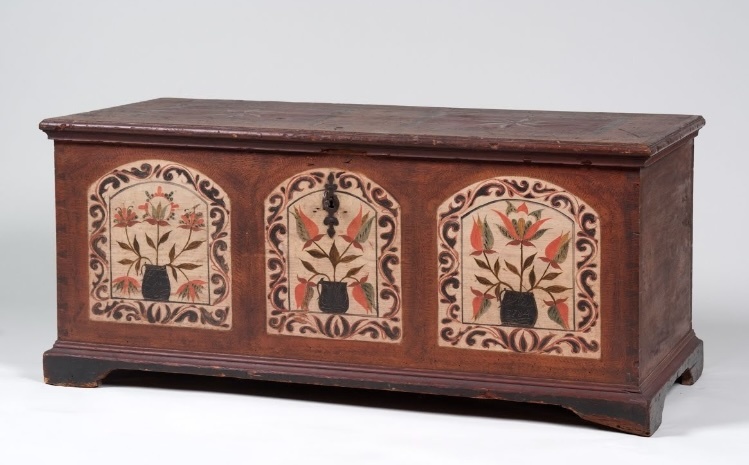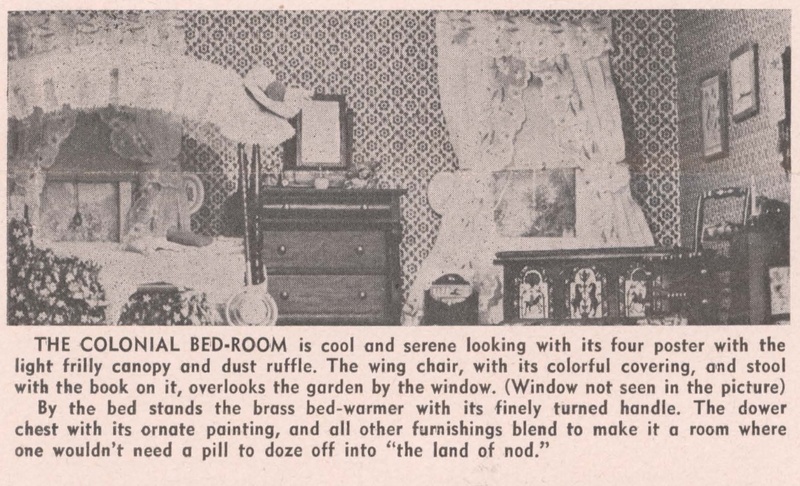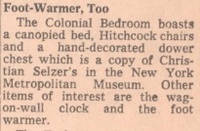The Colonial Bedroom, Inspiration
Inspired by the Colonial Revival movement’s romantic take on early American interiors, this scene captures more than architecture: it captures the spirit of the atmosphere. From the delicate canopy bed to the hand-painted dower chest, every piece tells a story of life in a young and evolving nation, where function coexisted under a roof of hard-earned simplicity.
Though one’s eyes may quickly fly to the larger pieces in the room, such as the ornate canopy bed with matching mahogany standing dresser, the smaller personal pieces provide us with historical context as well.
In particular, a dower chest sitting in the corner of the room. Fisher drew inspiration from a well-known piece by Christian Seltzer, displayed at the time in the Metropolitan Museum of Art in New York.
These details provide a glimpse of American immigration, as German immigrants brought rich traditions of craftsmanship like this to the United States. This beautifully decorated piece was often given to young women as a portion of a dowry, and filled with linens, clothing, and other items preparing them for their marriage.

Dower chest by Christian Seltzer c. 1784, Google Arts & Culture; ACD October 2024
Alan Kaylor Cline, a researcher with the University of Texas, explains the history provided by the National Gallery of Art:
Thus, they offer more story than storage, symbolizing familial heritage and bringing old world traditions into new chapters!
Now let's head over to the last two installments!


![<a href="/omeka/items/browse?advanced%5B0%5D%5Belement_id%5D=50&advanced%5B0%5D%5Btype%5D=is+exactly&advanced%5B0%5D%5Bterms%5D=A+Photograph+of+the+Brass+Foot-Warmer+in+Mrs.+Fisher%27s+Dollhouse%2C+Colonial+Bedroom%2C+%5Bca.+1950s-1960s%5D">A Photograph of the Brass Foot-Warmer in Mrs. Fisher's Dollhouse, Colonial Bedroom, [ca. 1950s-1960s]</a> <a href="/omeka/items/browse?advanced%5B0%5D%5Belement_id%5D=50&advanced%5B0%5D%5Btype%5D=is+exactly&advanced%5B0%5D%5Bterms%5D=A+Photograph+of+the+Brass+Foot-Warmer+in+Mrs.+Fisher%27s+Dollhouse%2C+Colonial+Bedroom%2C+%5Bca.+1950s-1960s%5D">A Photograph of the Brass Foot-Warmer in Mrs. Fisher's Dollhouse, Colonial Bedroom, [ca. 1950s-1960s]</a>](https://omeka.wilkes.edu/omeka/files/thumbnails/157d1fb50ba36b68ff9a4e806f75af68.jpg)
![<a href="/omeka/items/browse?advanced%5B0%5D%5Belement_id%5D=50&advanced%5B0%5D%5Btype%5D=is+exactly&advanced%5B0%5D%5Bterms%5D=A+Newspaper+article+entitled+%E2%80%9CMiniature+Room+Display+Has+141+Items%2C%22+about+Mrs.+Fisher%27s+Dollhouse%2C+%5Bca.+1940s-1960s%5D">A Newspaper article entitled “Miniature Room Display Has 141 Items," about Mrs. Fisher's Dollhouse, [ca. 1940s-1960s]</a> <a href="/omeka/items/browse?advanced%5B0%5D%5Belement_id%5D=50&advanced%5B0%5D%5Btype%5D=is+exactly&advanced%5B0%5D%5Bterms%5D=A+Newspaper+article+entitled+%E2%80%9CMiniature+Room+Display+Has+141+Items%2C%22+about+Mrs.+Fisher%27s+Dollhouse%2C+%5Bca.+1940s-1960s%5D">A Newspaper article entitled “Miniature Room Display Has 141 Items," about Mrs. Fisher's Dollhouse, [ca. 1940s-1960s]</a>](https://omeka.wilkes.edu/omeka/files/thumbnails/4fc5554a59188b453cd47ed7c87d9acd.jpg)
![<a href="/omeka/items/browse?advanced%5B0%5D%5Belement_id%5D=50&advanced%5B0%5D%5Btype%5D=is+exactly&advanced%5B0%5D%5Bterms%5D=A+Photograph+of+the+Dower+Chest%2C+Painted%2C+in+Mrs.+Fisher%27s+Colonial+Bedroom%2C+%5Bca.+1950s-1960s%5D">A Photograph of the Dower Chest, Painted, in Mrs. Fisher's Colonial Bedroom, [ca. 1950s-1960s]</a> <a href="/omeka/items/browse?advanced%5B0%5D%5Belement_id%5D=50&advanced%5B0%5D%5Btype%5D=is+exactly&advanced%5B0%5D%5Bterms%5D=A+Photograph+of+the+Dower+Chest%2C+Painted%2C+in+Mrs.+Fisher%27s+Colonial+Bedroom%2C+%5Bca.+1950s-1960s%5D">A Photograph of the Dower Chest, Painted, in Mrs. Fisher's Colonial Bedroom, [ca. 1950s-1960s]</a>](https://omeka.wilkes.edu/omeka/files/thumbnails/4d2df9dbddaaa3aec8270b0febe647d3.jpg)